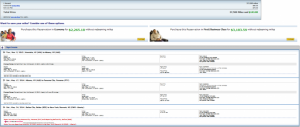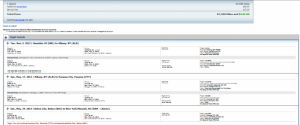A few days ago we discussed the topic of maximizing off peak economy awards through American Airlines Milesaaver awards. These awards are a great and relatively straightforward way to get 1.5 legs covered for two vacations that occur within a year of one another. However, United also provides wonderful opportunities to combine two trips and if done correctly, can result in even bigger benefits.
Maximizing stopovers with United can be as complicated or as simple as you’d like to make it. In other words, the way the United computers are programmed, there are various opportunities to tie many trips together if you look and work hard enough. But regardless, the computers almost always adhere to United’s unpublished award rules. Those rules are: 1: You get one stopover. A stopover is more than 24 hours internationally and more than 4 hours domestically (unless it’s the last flight of the day) in a destination at which you land, and from which you depart. 2: You get two open jaws. An open jaw is when you land at one airport and depart from another (as long as they are not co-terminals). And 3: you only get stopovers or open jaws on roundtrip tickets.
Let’s look at these rules a bit more closely. Here’s an example of a stopover. You decide you want to fly to Bangkok on Eva Airlines from the US. You settle on the New York to Taipei to Bangkok route. But you’ve never been to Taiwan before and would like to check it out for a few days before heading onto Bangkok. Taipei would be your stopover point. Many may assume that you would be allowed to stopover wherever your ticket takes you for as long as you want because you’re not going out of your way. This is incorrect. United only allows one stopover per ticket.
And here are a few examples of open jaws. Utilizing the above example, a typical open jaw would have you fly into Bangkok, but out of Phenom Penh, for example. You make your way from one city to the next via another means which is not part of your award ticket. Another open jaw example would be you start your roundtrip from New York because you were already going to be there on business but you want to return to Los Angeles because that’s where you live. This is also an open jaw because your return ticket does not take you back to where you started.
So, because I love Hawaii so much, let’s take a look at an example that begins in Honolulu. I have family who live in Albany, NY which is serviced by United, but certainly not a hub. These family members found themselves with a one way to Hawaii without a return and have talked about visiting Central America later next year. You’ll see on United’s award chart that a one way trip from Hawaii to the US is 20,000 miles in economy and 40,000 miles in business class. You’ll also see that a roundtrip from the mainland US/Alaska/Canada to Central America is 35,000 in economy and 60,000 in business class. One would assume that if you wanted to travel from Honolulu to Albany and then later in the year from Albany to Central America and back, the price would be 55,000 in economy and 97,500 in business class. Wrong.
See these two screen shots below (sorry they are so small!). Utilizing the “multiple destinations” tab in the United award search engine allows us to combine these trips as far as the computer is concerned, but break them into two trips for our actual use. So, you’ll see that by combing these two trips into one results in the required mileage of 37,500 in economy and 67,500 miles in business.
Astute readers may also observe that there appears to be three open jaws and a stopover in this itinerary. I’m not sure why United’s award engine is pricing this award, but it did. Maybe I’m missing something, does anybody know? To complicate matters, I put a similar itinerary on hold while I moved miles around for this couple. When I revisited the itinerary, one of the legs was errantly in economy class even though there was business class availability. So, I called up United and asked for them to simply change that leg into business class. The agent confirmed availability, but was shocked by the mileage total so brought in a supervisor. That supervisor spoke with another supervisor and said that I should not have been able to ticket this as the mileage was incorrect. So, they didn’t cancel the award, but weren’t going to change the economy leg either. I eventually called back and got an agent to change it, but keep that in mind as you are compiling your awards! United agents don’t like to see complicated awards at deeply discounted prices!
In short, there are several of these examples using United’s multiple destination award search tool. You just have to spend some time taking a look at your travel goals and leverage routing rules that allow you to get more for less! This is a bit of a complicated topic so if you have any questions, please feel free to ask!


Having squeezed up to 13 flights on my “round-trip” award tickets and routinely pushing United’s computer and res agent’s limits, I just wanted to share that they have never actually cancelled an award on me because it was ticketed “incorrectly” or “should not have been ticketed in the first place”. Just hang up and call later (as in hours and hours later so you don’t run into the same supervisor). I also found that midnight folks are always the best to deal with and are more willing to go along with crazy itineraries for the simple fact that they are bored there at 2am (unless, of course, there is a huge snowstorm that left them with a mess to sort through from the evening shift). So try and try again. Anything is possible with United. I have had many rules overwritten by agents to get my trips set up as I wanted.
Yeah I agree you can have success and it’s good to try to build things like that, but for me once I have them I tend to leave them.
Let sleeping dogs lie 🙂